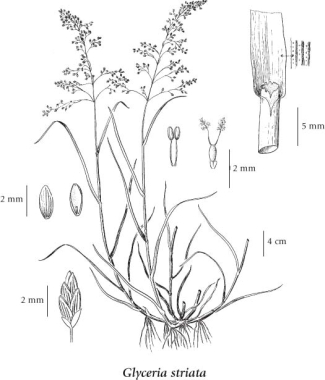Glyceria striata (Lam.) Hitchc.
fowl mannagrass
Poaceae (Grass family)
Introduction to Vascular Plants
fowl mannagrass
Poaceae (Grass family)
Introduction to Vascular Plants
Species Information click to expand contents
General:
Perennial, usually strongly tufted grass from rhizomes; stems erect to more or less decumbent, hollow, up to (20) 30-80 (100) cm tall.
Leaves:
Sheaths somewhat flattened, minutely rough, the hairs directed backwards, usually closed to the tops and often split; blades 2-5 (6) mm wide, flat or folded, mostly erect, minutely rough; ligules cut off at the ends to blunt, usually closed in the front unless split, minutely rough, the margins more or less irregularly jagged, 1.5-3 (4) mm long, the lower leaf ligules mostly 1-3 mm long.
Flowers:
Inflorescence a loose panicle, 7-20 cm long, the slender branches usually ascending; spikelets mostly (3-) 4- to 7-flowered, egg-shaped, about 3.8 mm long and 1.5 mm wide; glumes egg-shaped, usually more or less fringed with fine hairs, the margins more or less jagged, usually rounded to blunt, the lower ones 0.6-1.5 mm long, the upper ones about 0.9-2.3 mm long; lemmas broad, firm, barely 2 mm long, prominently 7-nerved, smooth or minutely rough on the nerves, the marginal nerves less conspicuous; paleas abruptly notched, the slits narrow, concealed by the lemmas; stamens 2; anthers 0.4-0.6 mm long.
Illustration click to expand contents

If more than one illustration is available for a species (e.g., separate illustrations were provided for two subspecies) then links to the separate images will be provided below. Note that individual subspecies or varietal illustrations are not always available.
Illustration Source: The Illustrated Flora of British Columbia
USDA Species Characteristics click to expand contents
Flower Colour:
Green
Blooming Period:
Early Summer
Fruit/Seed characteristics:
Colour: Red
Present from Spring to Fall
Source: The USDA
Ecology click to expand contents
Ecological Framework for Glyceria striata
The table below shows the species-specific information calculated from
original data (BEC database) provided by the BC Ministry of Forests and Range.
(Updated August, 2013)
The table below shows the species-specific information calculated from
original data (BEC database) provided by the BC Ministry of Forests and Range.
(Updated August, 2013)
| Site Information |
Value / Class |
||
|
Avg |
Min |
Max |
|
| Elevation
(metres) |
946 | 1 | 1840 |
| Slope
Gradient (%) |
1 | 0 | 42 |
|
Aspect (degrees) |
255 | 0 | 360 |
| Soil
Moisture Regime (SMR) [0 - very xeric; 4 - mesic; 8 - hydric] |
6 | 3 | 8 |
| Modal
Nutrient Regime
Class |
D | ||
| #
of field plots species was recorded in: |
199 | ||
| Modal
BEC Zone Class |
IDF | ||
|
All BEC Zones (# of stations/zone) species was recorded in |
BAFA(1), BG(7), BWBS(14), CWH(5), ESSF(6), ICH(43), IDF(48), MH(1), MS(20), PP(2), SBPS(10), SBS(34), SWB(3) | ||
|
Source:
Klinkenberg 2013
|
|||
Habitat and Range click to expand contents
Bogs, lakeshores and moist to wet meadows in the lowland to subalpine zones; common in S BC south of 55 degrees N, infrequent northward, absent on the Queen Charlotte Islands; N to AK, YT and NT, E to NF and S to ME, MA, PA, NC, FL, MS, LA, TX, NM, AZ and CA.
Status Information click to expand contents
Synonyms click to expand contents
Synonyms and Alternate Names:
Glyceria nervata (Willd.) Trin.
Glyceria striata subsp. stricta (Scribn.) Hultén
Glyceria striata var. stricta (Scribn.) Fernald
Panicularia nervata (Willd.) Kuntze
Panicularia striata (Lam.) Hitchc.